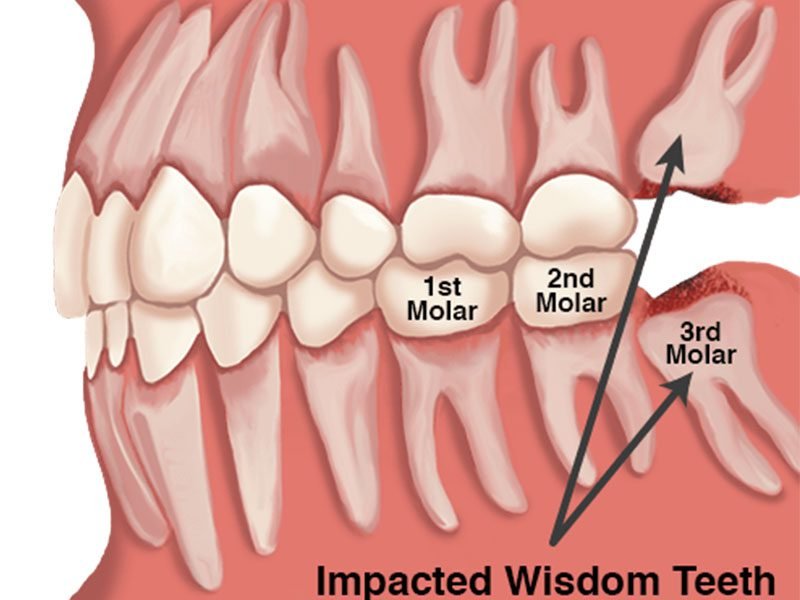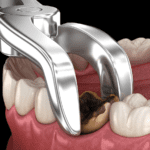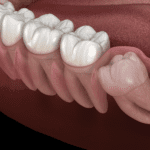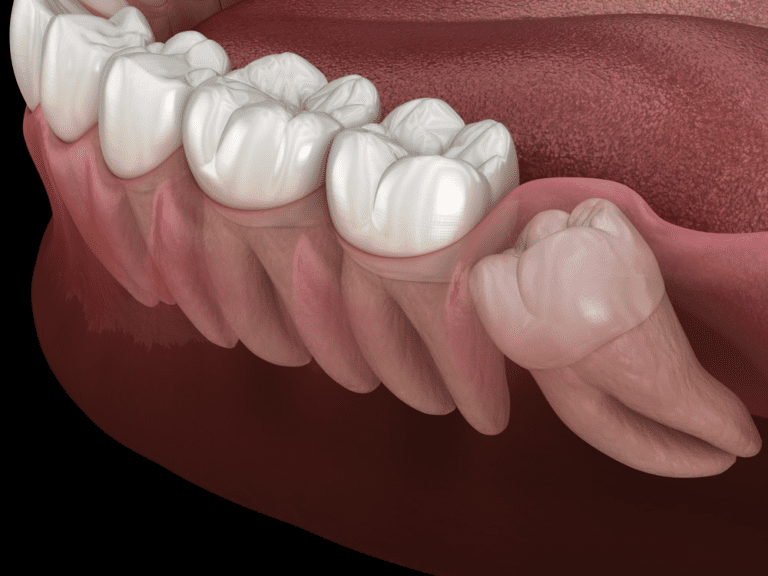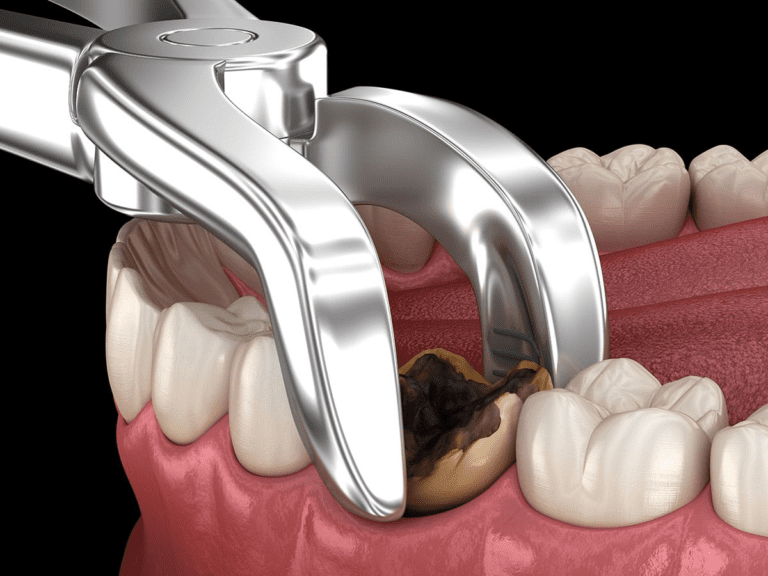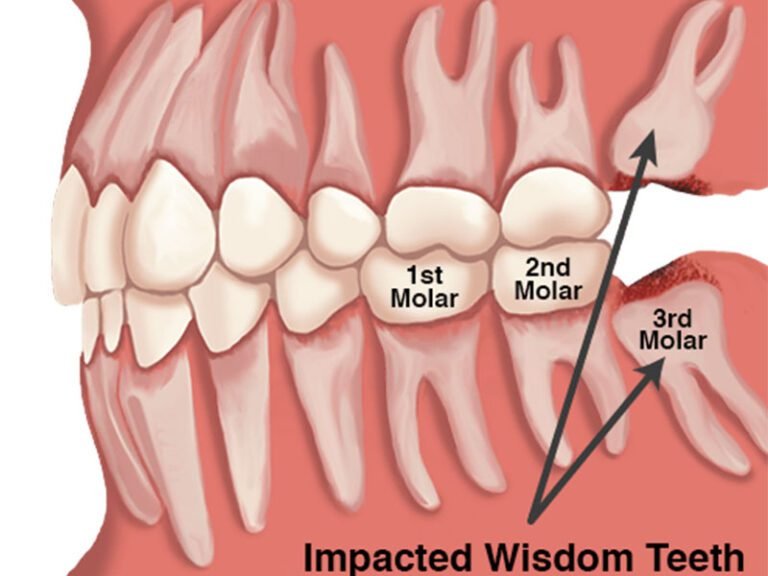Table of Contents
When do wisdom teeth usually start to grow?
Wisdom teeth, also known as third molars, typically begin to grow between the ages of 17 and 25. This stage of life is commonly referred to as the “age of wisdom teeth eruption.” However, the exact timing may vary for each individual. The eruption of wisdom teeth can be unpredictable and may not follow the same timeline for everyone.
The growth of wisdom teeth can bring about several oral health concerns. Due to a lack of space in the jaw, these teeth often emerge in an improper position or become impacted. Impacted wisdom teeth can lead to a range of problems, including pain, infection, damage to adjacent teeth, and the development of cysts or tumors. In some cases, impacted wisdom teeth may not cause any noticeable symptoms initially, making regular dental check-ups crucial for early detection and intervention.
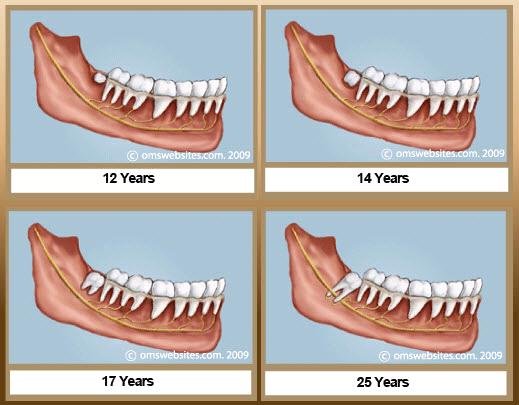
Problems that can occur when wisdom teeth grow
Wisdom teeth, also known as third molars, typically begin to grow in the late teens or early twenties. While some people may not experience any problems with their wisdom teeth, others may encounter a range of issues as these molars erupt. One common problem is overcrowding, where there isn’t enough space in the mouth for the wisdom teeth to fully come in. This can lead to misalignment of the surrounding teeth, causing pain and discomfort. Additionally, impacted wisdom teeth can occur when the teeth become trapped beneath the gums, leading to pain, swelling, and infection. If left untreated, impacted wisdom teeth can cause damage to neighboring teeth and even the jawbone.
Another problem that can arise when wisdom teeth grow is the development of cysts. A cyst is a fluid-filled sac that forms around the impacted tooth. It can cause significant pain and swelling and may lead to infection or even bone loss if left untreated. Furthermore, wisdom teeth can sometimes only partially emerge, leaving a flap of gum tissue covering part of the tooth. This creates a pocket where food particles and bacteria can easily get trapped, leading to gum inflammation and infection. These problems highlight the importance of closely monitoring the growth and development of wisdom teeth and seeking professional dental care if any issues arise.
| Year | Potential Problems |
|---|---|
| Year 1 | Impaction |
| Crowding of other teeth | |
| Pain and discomfort | |
| Infection around the gums | |
| Year 2 | Increased impaction |
| Damage to adjacent teeth | |
| Formation of cysts | |
| Gum disease | |
| Year 3 | Further crowding |
| Development of abscesses | |
| Sinus pain and pressure | |
| Difficulty in chewing | |
| Year 4 | Nerve damage |
| Bone loss around the teeth | |
| TMJ issues | |
| Risk of cavities | |
| Year 5 | Severe infections |
| Increased risk of periodontal disease | |
| Potential tooth decay | |
| Increased risk of complications during extraction |
Signs and symptoms of impacted wisdom teeth
Signs and symptoms of impacted wisdom teeth can vary from person to person, but there are several common indicators to look out for. One of the most prominent signs is persistent pain or discomfort in the back of the mouth, specifically around the area where the wisdom teeth are located. This pain may worsen while chewing or opening the mouth wide.
Another symptom of impacted wisdom teeth is swelling and inflammation of the gums surrounding the affected area. This can result in redness, tenderness, and even bleeding during brushing or flossing. Additionally, bad breath or an unpleasant taste in the mouth can occur as a result of food particles becoming trapped in the pockets created by the impacted teeth.
It is important to note that some individuals may not experience any noticeable symptoms even if their wisdom teeth are impacted. Regular dental check-ups and X-rays are crucial for detecting impacted wisdom teeth early on, as they can sometimes be asymptomatic and cause problems later if left untreated.
| Sign/Symptom | Description |
|---|---|
| Pain | – Dull, persistent pain in the back of the mouth where the wisdom teeth are located |
| Swelling | – Swelling and tenderness in the gums around the affected area |
| Difficulty opening jaw | – Limited ability to fully open the mouth due to swelling and discomfort |
| Redness | – Inflammation and redness of the gums surrounding the wisdom teeth |
| Bad breath | – Foul odor caused by the accumulation of food particles and bacteria in the impacted area |
| Difficulty chewing | – Discomfort or pain while chewing, especially when the impacted tooth comes into contact with other teeth |
| Headaches | – Persistent headaches, often radiating from the jaw and temple areas |
| Earaches | – Pain or discomfort in the ears, often due to pressure exerted by the impacted wisdom teeth |
| Jaw stiffness | – Stiffness and soreness in the jaw muscles, especially upon waking or after prolonged periods of chewing |
| Crowding | – Crowding or shifting of adjacent teeth as the impacted wisdom tooth pushes against neighboring teeth |
| Development of cysts | – Formation of cysts around the impacted tooth, leading to further pain and complications |
| Difficulty swallowing | – Sensation of difficulty or discomfort while swallowing, especially if the impacted tooth causes throat irritation |
How are impacted wisdom teeth diagnosed?
Diagnosing impacted wisdom teeth requires a thorough examination by a dental professional. During the examination, the dentist will assess the positioning and eruption status of the wisdom teeth using various diagnostic tools. X-rays are commonly used to get a clear view of the wisdom teeth and determine if they are impacted or if there are any other issues present.
In addition to X-rays, the dentist may also perform a visual examination and consider the symptoms reported by the patient. Signs of impacted wisdom teeth may include pain, swelling, redness, bad breath, difficulty opening the mouth, and discomfort while chewing. These symptoms, along with the dental examination and X-ray findings, aid in making an accurate diagnosis of impacted wisdom teeth. It is important to note that not all wisdom teeth need to be removed, but a proper diagnosis is crucial in determining the appropriate course of action for each individual case.
Complications that can arise from impacted wisdom teeth
Complications can arise when wisdom teeth become impacted, meaning they are unable to fully emerge from the gums. One common complication is infection. When the wisdom tooth is partially erupted and difficult to clean, bacteria can easily accumulate around the area, leading to gum inflammation and infection known as pericoronitis. This can cause symptoms such as pain, swelling, bad breath, and difficulty in opening the mouth.
Another complication that can arise from impacted wisdom teeth is tooth decay. When the wisdom tooth is positioned in a way that makes it hard to reach with a toothbrush or dental floss, it becomes more susceptible to decay. The tight space between the wisdom tooth and its neighboring teeth can trap food particles, promoting the growth of bacteria and the development of cavities. If left untreated, tooth decay can progress and affect the adjacent teeth, leading to further dental problems.
Reasons why wisdom teeth need to be removed
Wisdom teeth, also known as third molars, are the final set of teeth to erupt in the mouth. While some individuals may not experience any issues with their wisdom teeth, there are several reasons why these teeth may need to be removed.
One common reason for wisdom tooth extraction is due to their potential to cause overcrowding in the mouth. As the wisdom teeth attempt to emerge, they often do not have enough space to fully erupt. This can lead to the teeth becoming impacted, meaning they are unable to fully break through the gum line. The presence of impacted wisdom teeth can cause pain, discomfort, and alignment issues with the surrounding teeth. In such cases, removal of the wisdom teeth becomes necessary to prevent further dental complications.
Another reason why wisdom teeth may need to be removed is the increased risk of developing oral infections. Since the wisdom teeth are located at the back of the mouth, they can be difficult to clean and maintain proper oral hygiene. This can create an environment that is more susceptible to the growth of bacteria, leading to infections such as pericoronitis. Pericoronitis is an inflammation of the tissue surrounding the partially erupted tooth and can result in swelling, pain, and difficulty in opening the mouth. In order to prevent recurring infections and protect overall oral health, removal of the affected wisdom teeth is often recommended.
In conclusion, the need for wisdom tooth removal arises from various factors such as overcrowding and the potential for oral infections. By understanding the reasons behind wisdom tooth extraction, individuals can make informed decisions regarding their dental health and seek timely intervention to prevent potential complications.
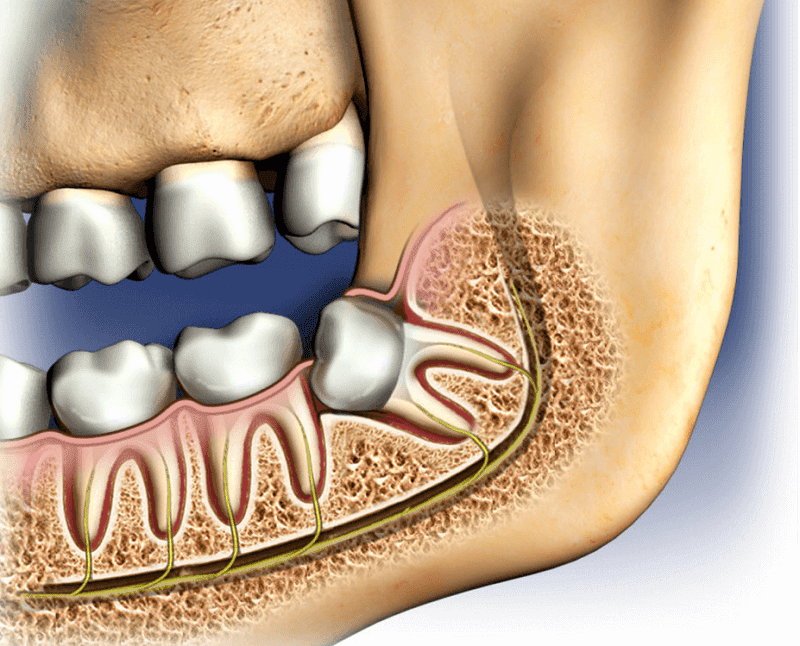
The importance of early removal of wisdom teeth
Early removal of wisdom teeth is crucial for maintaining optimal oral health. Wisdom teeth, also known as third molars, typically begin to grow in between the ages of 17 to 25. However, these late-developing teeth often face limited space in the mouth, which can lead to various issues if left untreated.
One of the main problems that can arise from wisdom teeth growth is impaction. When there is not enough space for the wisdom teeth to fully emerge, they may become partially or fully trapped beneath the gums. This can result in pain, swelling, and even infection. In some cases, impacted wisdom teeth can also cause damage to neighboring teeth and increase the risk of periodontal disease. By addressing these concerns early on, the chances of complications and discomfort can be significantly reduced, promoting overall oral wellbeing.
Common procedures for removing wisdom teeth
Wisdom tooth extraction is a common dental procedure that involves the removal of one or more wisdom teeth, also known as third molars. These teeth typically erupt between the ages of 17 and 25, and often cause problems due to their size and position.
The procedure for removing wisdom teeth varies depending on factors such as the tooth’s position, the patient’s age, and the presence of any complications. In cases where the wisdom teeth have fully erupted and are easily accessible, a simple extraction may be performed. This involves numbing the area with local anesthesia and gently loosening the tooth from its socket before removing it.
However, if the wisdom teeth are impacted or have not fully erupted, a surgical extraction may be necessary. This procedure involves making an incision in the gum to access the tooth, removing any bone that obstructs its path, and dividing the tooth into smaller pieces for easier extraction. In some cases, stitches may be required to close the incision and promote proper healing.
Regardless of the specific procedure, it is important to consult with a dental professional to determine the best course of action for removing wisdom teeth. They will consider various factors such as the patient’s oral health, the presence of any symptoms or complications, and the potential risks and benefits of the extraction. By taking these factors into account, a dentist can provide personalized care and ensure a successful and comfortable extraction process.
What to expect during a wisdom tooth extraction
During a wisdom tooth extraction, it is important to have realistic expectations about the procedure. The process typically begins with a local anesthesia to numb the area around the tooth, ensuring a pain-free experience. In some cases, the dentist may recommend general anesthesia to induce sleep or sedation to help you relax. Once the anesthesia takes effect, the dentist will proceed with the extraction.
Using specialized instruments, the dentist will carefully remove the wisdom tooth. The procedure involves making an incision in the gum tissue to access the tooth, and in some cases, removing a small amount of bone to gain better access. Depending on the tooth’s position and complexity, the dentist may divide the tooth into sections to make extraction easier. Once the tooth is extracted, the dentist may need to stitch the gums to promote proper healing. The entire process usually takes about 45 minutes to an hour, but the duration may vary depending on individual circumstances.
Recovery process after wisdom tooth extraction
After undergoing a wisdom tooth extraction, it is important to take proper care of yourself to ensure a smooth and speedy recovery. The recovery process can vary from person to person, but there are some general guidelines that can help you navigate this period effectively.
First and foremost, you should expect some swelling and discomfort in the first few days following the extraction. Applying an ice pack to the affected area for brief periods of time can help reduce swelling and alleviate pain. It is also advisable to take pain medication as recommended by your dentist to manage any discomfort.
However, avoid using aspirin, as it can increase the risk of bleeding. Additionally, you may need to follow a soft or liquid diet for a few days to avoid putting too much pressure on the extraction site. Regularly rinsing your mouth with warm saltwater can help keep the area clean while promoting healing. Finally, it is crucial to avoid smoking, using a straw, or engaging in any activities that can disrupt the blood clot formation at the extraction site, as this can lead to a painful condition called dry socket.
Possible risks and complications of wisdom tooth extraction
While wisdom tooth extraction is a common and generally safe dental procedure, there are potential risks and complications that patients should be aware of. It is important to have a discussion with your dentist or oral surgeon about these possibilities before undergoing the extraction.
One possible risk is infection. After the extraction, the socket where the tooth was removed can become infected. This can happen if bacteria enter the open wound. Signs of infection may include fever, increasing pain, swelling, and discharge from the extraction site. In some cases, antibiotics may be needed to treat the infection.
Another potential complication is damage to surrounding structures. Wisdom teeth are located near important structures such as nerves, sinuses, and adjacent teeth. During the extraction process, there is a small risk of injuring these structures. Nerve damage can result in numbness or tingling in the lower lip, tongue, or chin. Damage to adjacent teeth can occur if the extraction instrument accidentally hits them. It is important to choose an experienced dentist or oral surgeon to minimize the chances of these complications.
Alternatives to wisdom tooth extraction
While wisdom tooth extraction is a common procedure, there are alternatives that can be considered depending on the specific case. One alternative is monitoring the growth and development of the wisdom teeth through regular dental check-ups and X-rays. In certain cases, wisdom teeth may grow in an ideal position and not cause any problems. In such situations, it may be decided to leave them as they are, provided they can be properly cleaned and maintained.
Another alternative is the use of orthodontic treatment to create more space in the mouth for the wisdom teeth to grow in a proper alignment. This can be done by using braces or aligners to gradually shift the teeth and create space in the arch. However, it is important to note that this option is not suitable for everyone, and the decision should be made in consultation with a dental professional.
It is crucial to consult with a dentist or oral surgeon to determine the most appropriate alternative to wisdom tooth extraction based on individual circumstances. They will consider factors such as the position and alignment of the wisdom teeth, the impact on surrounding teeth and structures, and the potential for future problems.
When is it necessary to remove wisdom teeth?
Wisdom teeth, also known as third molars, are the last set of teeth to emerge in the mouth. They typically start to grow between the ages of 17 and 25. However, not everyone develops wisdom teeth, and for those who do, their eruption can bring about a range of issues.
In some cases, wisdom teeth emerge without causing any problems. However, more often than not, they become impacted, meaning they do not have enough space to fully come through the gum line. This can lead to a host of complications, including pain, swelling, infection, and damage to surrounding teeth. Additionally, partially erupted wisdom teeth can be difficult to clean properly, increasing the risk of tooth decay and gum disease. Consequently, it is necessary to remove wisdom teeth when they pose potential or existing dental issues. Early detection and intervention can help prevent further problems and ensure optimal oral health.

Factors to consider before deciding to remove wisdom teeth
When considering whether to remove wisdom teeth, there are several important factors that need to be taken into account. First and foremost, the position and alignment of the wisdom teeth should be assessed. If the teeth are properly aligned and able to fully emerge from the gums without causing any issues, removal may not be necessary. However, if the teeth are impacted or growing at an angle that poses a risk to the surrounding teeth or jawbone, extraction is often recommended.
Another factor to consider is the individual’s oral hygiene and susceptibility to dental problems. Wisdom teeth are located at the back of the mouth, making them difficult to clean properly. This can increase the risk of tooth decay and gum disease. If the person has a history of dental issues or struggles to maintain good oral hygiene, removing the wisdom teeth may be the best course of action to prevent future problems.
Additionally, the presence of symptoms such as pain, swelling, or infection should be considered. These can indicate that the wisdom teeth are causing problems and need to be removed. It’s important to remember that even if there are no symptoms currently present, complications can still arise in the future. Regular dental check-ups and X-rays can help detect any potential issues and determine whether removal is necessary.
Overall, the decision to remove wisdom teeth should be made on a case-by-case basis, taking into account the individual’s specific circumstances and the professional assessment of a dentist or oral surgeon. Factors such as alignment, oral hygiene, symptoms, and potential risks should all be carefully considered before making a final decision.
Benefits of removing wisdom teeth
Removing wisdom teeth can offer several benefits for both oral and overall health. One of the primary advantages is the prevention of potential dental complications. Wisdom teeth, also known as third molars, often do not have enough space to properly erupt, leading to impaction. This can result in numerous problems such as pain, infection, gum disease, and tooth decay. Removing these teeth before they cause issues can help avoid these complications and maintain optimal oral health.
Another benefit of removing wisdom teeth is the prevention of orthodontic issues. If the wisdom teeth are not extracted, they can push against the adjacent teeth, causing misalignment and crowding. This can potentially undo prior orthodontic treatments, leading to the need for further interventions. By removing the wisdom teeth, the natural alignment of the existing teeth can be preserved, reducing the risk of orthodontic problems and maintaining a healthy and well-aligned smile.
Post-surgery care tips for wisdom tooth extraction
After undergoing a wisdom tooth extraction, proper post-surgery care is essential to promote healing and minimize complications. Here are some important tips to keep in mind:
1. Manage pain and swelling: It is typical to experience some discomfort after the procedure. Take the prescribed pain medication as directed by your dentist to manage pain effectively. Applying an ice pack to the affected area for 20 minutes at a time in the first 24 hours can also help reduce swelling.
2. Take it easy: Rest is crucial during the initial days following the surgery. Avoid strenuous activities and try to keep your head elevated when lying down to minimize swelling. Taking time off from work or school is recommended to ensure a smoother recovery.
These tips will aid in a speedy recovery after wisdom tooth extraction. However, it’s important to note that everyone’s healing process may vary, so it’s best to consult with your dentist for personalized post-surgery care instructions.
How long does it take for wisdom teeth to start growing?
Wisdom teeth typically start to grow between the ages of 17 and 25.
What problems can occur when wisdom teeth grow?
Problems that can occur when wisdom teeth grow include overcrowding, misalignment, infection, and impacted teeth.
What are the signs and symptoms of impacted wisdom teeth?
Signs and symptoms of impacted wisdom teeth may include pain, swelling, difficulty opening the mouth, bad breath, and a bad taste in the mouth.
How are impacted wisdom teeth diagnosed?
Impacted wisdom teeth are usually diagnosed through dental examination, X-rays, and sometimes, a panoramic radiograph.
What complications can arise from impacted wisdom teeth?
Complications from impacted wisdom teeth can include infection, damage to surrounding teeth, cysts or tumors, and jawbone damage.
Why do wisdom teeth need to be removed?
Wisdom teeth often need to be removed due to the risk of complications such as infections, damage to adjacent teeth, and overcrowding.
Why is early removal of wisdom teeth important?
Early removal of wisdom teeth is important to prevent future complications and to minimize the risks associated with the extraction procedure.
What are the common procedures for removing wisdom teeth?
Common procedures for removing wisdom teeth include simple extractions and surgical extractions.
What can I expect during a wisdom tooth extraction?
During a wisdom tooth extraction, the area will be numbed with anesthesia, and the tooth will be carefully extracted using specialized tools.
What is the recovery process like after wisdom tooth extraction?
The recovery process after wisdom tooth extraction involves rest, pain management, following post-operative instructions, and a soft food diet.
What are the possible risks and complications of wisdom tooth extraction?
Possible risks and complications of wisdom tooth extraction include infection, dry socket, nerve damage, bleeding, and swelling.
Are there alternatives to wisdom tooth extraction?
In some cases, alternatives to wisdom tooth extraction may include orthodontic treatment, regular monitoring, or addressing specific issues with the impacted teeth.
When is it necessary to remove wisdom teeth?
Wisdom teeth are usually removed when they are causing pain, infection, crowding, or other dental problems.
What factors should be considered before deciding to remove wisdom teeth?
Factors that should be considered before deciding to remove wisdom teeth include the position of the teeth, the patient’s age, oral hygiene, and the presence of any symptoms or complications.
What are the benefits of removing wisdom teeth?
The benefits of removing wisdom teeth include prevention of future complications, improved oral hygiene, and the relief of pain and discomfort.
What post-surgery care tips should I follow after wisdom tooth extraction?
Post-surgery care tips for wisdom tooth extraction include taking prescribed medications, applying ice packs, eating soft foods, maintaining oral hygiene, and avoiding strenuous activities.

